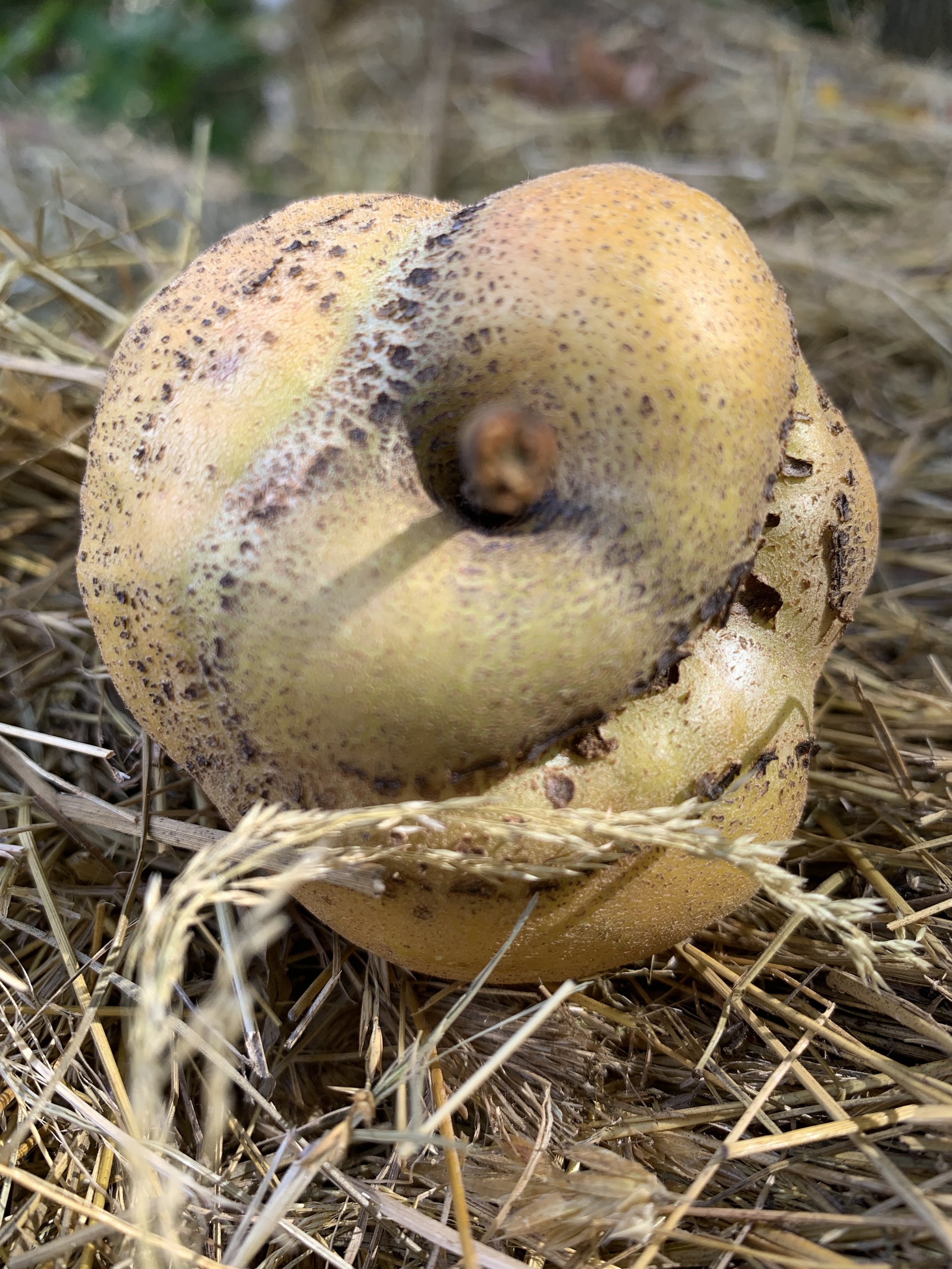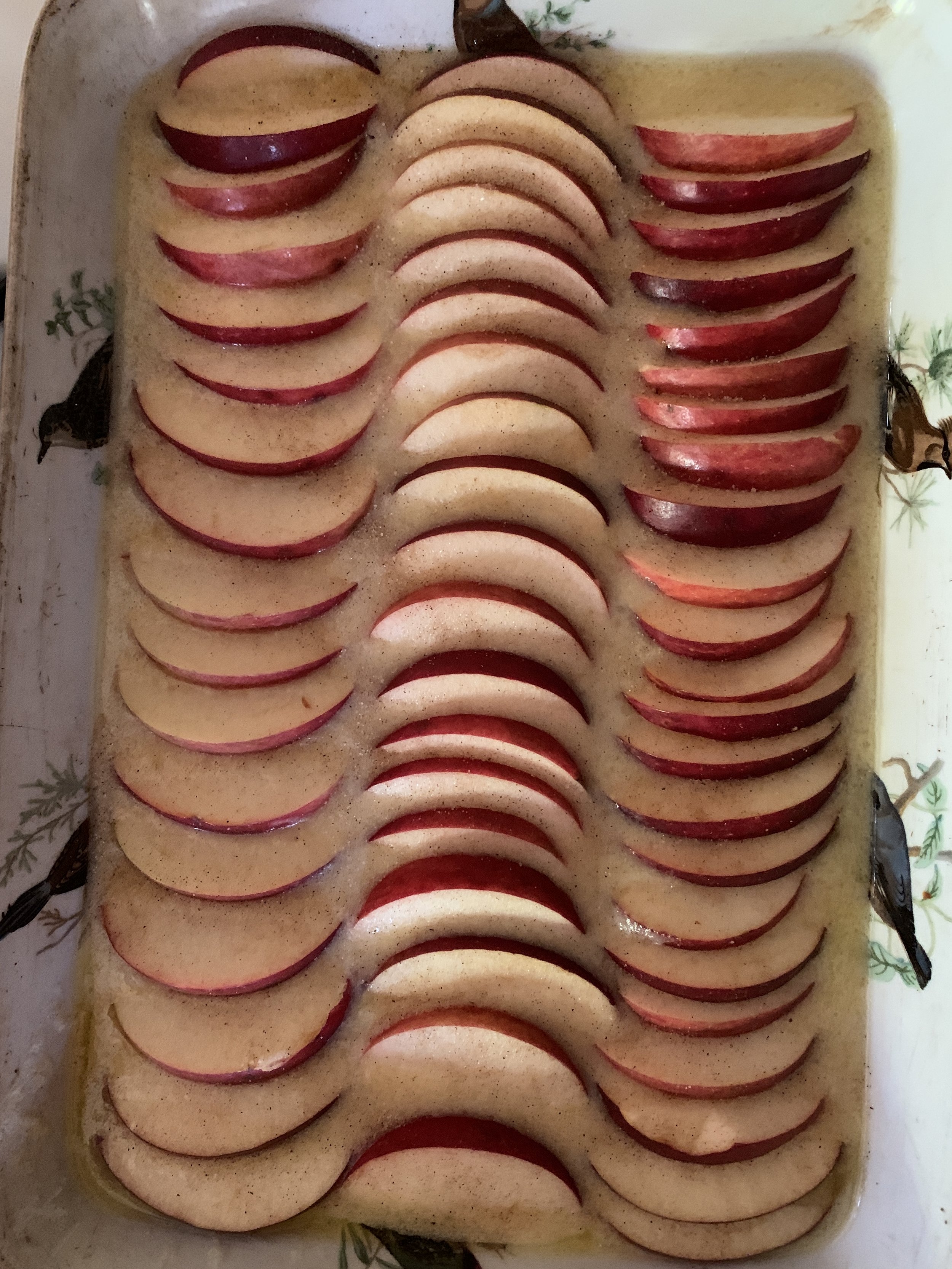Apple Tasting at the Common Ground Fair. Which is your favorite?
Like most specialties, the world of apples has a lingo all its own. Some of the words are familiar and used in general conversation. Others take on new definitions when applied to apples. And still others are as obscure as the apple parts and attributes they describe. If you listen to pomologists (persons who study apples) speak, they throw about words such as stellate, scarfskin, acuminate and connivent. They tend to geek out over these terms and rarely take more than a bite or two of any apple as they cut it open and dissect it into describable parts. These are certainly not terms that enhance the taste and enjoyment of apples. But there are a few terms that might help with your apple journey this fall - terms that we will use at times, if not frequently, to educate you about the apples in your share. They are:
Bloom - a naturally occurring, dusty film that covers red, purple and sometimes even yellow apples (think Milton). It is harmless and can be wiped off.
Blush - a patch of color covering part of the apple or occasionally the entire surface.
Crabapple - any apple under 2” in diameter - basically a small apple. It can be delicious or a “spitter”.
Dessert Fruit - an apple that is best eaten fresh, uncooked, out of hand or with a knife.
Russet - a skin condition that appears rough like suede. It can range in color from light tan to dark umber and may appear as a splash around the stem, in patches, as netting or as the complete covering of the fruit. The skin of the apple develops russeting in order to protect the fruit from damage caused by cracks in or abrasion of the epidermis. Certain fungicides can also cause skin to develop russet. It is not harmful to eat and may even enhance the flavor.
Season - time of year when the apple is ripe. In Maine that could be anytime from August to late winter. Apples that are considered keepers, such as Black Oxford and Northern Spy, may be harvested in late October but they are not ripe until the winter. They are winter apples.
Variety - any named apple that can only be reproduced by grafting. Pomologists refer to it as a “Cultivar”. Do not confuse it with the term “Species”. There are thousands of varieties/cultivars within the apple species Malus X DOMESTICA [SP: Malus x domestica]
If you want to learn more about apple nomenclature and how to identify and describe an apple, there is a detailed explanation of terms in John’s book Apples and the Art of Detection. You can also join John by zoom at the University of Idaho Heritage Orchard Conference on Oct 16 for his talk on Apple Identification 101.
Picks of the week:
(Click each variety for more info)
The Apple Tasting at the Common Ground Fair is the chance for the masses to experience Out on a Limb CSA in an hour, sort of like speed dating for apples. More accurately it is only one week of the CSA that Fair goers experience, but they do get to taste a variety of apples at the height of ripeness that for the most part they have never heard of or seen before. While it may not be as popular as the sheep dog demos, a lot of people cram in and around the Hayloft Tent for a tiny taste of apples. If you were there, you will recognize three apples from the Tasting that are part of your share this week. Three others, however, we didn’t include in the Tasting to make sure we had enough to share with you.
Two of the perennial winners at the Tasting are Canadian Strawberry and Chestnut Crab. Despite the variability of the growing season, they always seem to be ready to harvest the third week after Labor Day. These apples are crisp, flavorful, well balanced and juicy - just perfect for fresh eating. The original Maine Canadian Strawberry trees that are the progenitors of the apples at the Fair and in your share bag were found growing on a farm in Solon, ME. Recent DNA analysis has shown them to be one and the same as a NY apple called Washington Strawberry. We have no idea where the apple originated or why it wasn’t more widespread throughout old orchards in Maine, but we’re not surprised that it was voted “Best of Show” at the Tasting on Friday. Chestnut Crab often beats out Canadian Strawberry as the fan favorite, but not this year. Crabapples have a bad rap as sour and bitter and, as such, are often referred to as “spitters”. But a good crab can pack a delicious wallop since it concentrates all its flavor into a tiny package. We think Chestnut is one delicious crab.
The biggest surprise of the 2024 Apple Tasting was the apple that took home the crown on Saturday - Wealthy. We love this old Minnesota apple for cooking, and we never expected it to wow Fair goers. Usually tart pie apples are overshadowed by the more complex flavors of dessert apples. But the people have spoken so see what you think. If you don’t agree, then slice them up and cook with them. Either way, you’ll be richer.
About the same time that Wealthy was introduced in Excelsior, MN, St. Edmund’s Russet was discovered growing in an orchard in Edmunds, England. You won’t find this apple or any other russetted apple at your local super market since these days the rough skin is not a big seller in the US. We’re thankful that the Brits are more open-minded about unusual looking apples and took a bite of this one. St Edmund’s is the first russet to ripen in Maine, but unlike the later russets, it bruises easily and doesn’t keep long. And it can look pretty gnarly; covered with warts, bulges and zipper-like scars, it looks dressed for a Halloween party. But don’t be scared off; it’s excellent for fresh eating and also sliced and sauteed in butter.
Although King of Tompkins County was discovered in New Jersey way back in the 1700’s , it took nearly a century for it to become popular throughout Maine. Here is another dessert fruit that is tasty right off the tree in mid-fall, although this one will keep until January. We’ve grafted a bunch of Kings over at the Apple Farm in Fairfield in an effort to get more people to try it. Their customers have not yet turned their backs on Honeycrisp and Mac in favor of King, but we think you might give it a crown this week. If you notice that some of the flesh is rather glassy looking and juicy, that’s watercore. It results from a nutrient imbalance that causes the air spaces between the cells in the apple to fill with water and the sugar sorbitol. It may give the fruit a melon-like flavor.
Chenango Strawberry - handle with kid gloves
The last apple in the share is a newcomer. We’ve never been able to offer this summer apple before because it reliably drops and rots before the CSA begins. However, we recently found a source for enough Chenango Strawberry to supply all our shareholders, so we’re taking a chance that it will add favorably to your apple education. The beautiful pink/yellow pastel skin bruises as soon as you look at it. We’ve been as gentle as we could be packing this apple, but eat it NOW fresh, dried or in sauce. Who can believe that there are two strawberries in your share?
Our apples come to you straight from the tree, so, as with all fresh produce, please be sure to wash them thoroughly before eating. Some of the apples are grown using Integrated Pest Management by the orchards we collaborate with throughout Maine, and some are organically grown here on Super Chilly Farm.
Recipe of the Week
“Easy” must be the theme of the recipes that I’m attracted to this fall. It was certainly what caught my eye in the name of the Apple Buckle recipe I chose this week. Common Ground Fair weekend is always busy for us - people coming and going, large group dinners, long days at the Fair and very early mornings - so I needed a dessert I could whip up quickly that would feed a crowd. The original version of this recipe called for it to be cooked in a loaf pan which didn’t meet my needs. So I increased the recipe 50%, decreased the sugar and baked it in a 9”x13” oven-proof pan. I also added some cinnamon because it doesn’t seem right to bake apples without it. The recipe suggested that you could “arrange the apple slices in the batter with the rounded edges up”. My batter was so thin that there was no way I could make them stand up. So I stuck them in and overlapped them, just like a line of dominoes that had knocked each other over. It worked just fine. A word of warning for your dessert planning - the buckle takes an hour or more to cook. But that should give you plenty of time to prepare the rest of your meal while it’s in the oven.
Easy Apple Buckle (serves 12)
If the batter is too thin to hold up the apples, overlap them . They cook up just fine. this is the buckle right before it went in the oven.
Ingredients:
1 1/2 sticks unsalted butter
3 large, tart apples - try Wealthy
1 1/2 cups all-purpose flour
1 1/2 tsp kosher salt
3/4 tsp baking powder
1 1/4 cups sugar
1 1/2 cups whole milk
1 1/2 tsp vanilla extract
Cinnamon or cinnamon sugar for sprinkling on top
Ice cream for serving
Directions:
Heat oven to 375 degrees. Place rack in the center of the oven.
While the oven is heating, add the butter to a 9”x13” baking dish, and place in the oven until the butter has almost melted (about 5 minutes). Remove the pan from the oven, swirl a bit to melt the rest of the butter, and set aside to cool slightly.
Core and thinly slice the apples.
In a medium-sized bowl whisk together the flour, salt, sugar and baking powder. Add the milk and vanilla, and whisk until combined. Pour in the melted butter, and whisk again until the batter is blended and has no lumps. It may take a few minutes to get the butter incorporated.
Pour the batter into the warm 9”x13” pan. Line up the apple slices in three rows in the batter with the peel facing up. (See note above and picture.) Sprinkle the top with cinnamon or cinnamon sugar.
Bake until the edges are a bit crispy and chewy, the top is golden, and the buckle is set in the center. The apples will be tender, but still hold their shape. This may take 60-70 minutes.
Cool slightly before serving with ice cream.











